Donations help modernize classroomsContributions by alumni andfriends to the Classrooms for Tomorrowinitiative are updating the learningenvironment for Bumpers Collegestudents in the Agriculture and PlantScience buildings.AGRI 332 was transformed overthe past year into one of the bestequippedclassrooms on campus. Itincludes state-of-the-art computerizedmulti-media equipment, and it isequipped for computer interactivevideo (CIV) distance education classes.The U of A Division of Agricultureand Riceland Foods Foundationfunded the project.Renovations began this fall to turnanother Agriculture Building roominto the Pat Sullivan Memorial Classroomwith computer connections atstudent workspaces.Funds were providedby a cornerstone giftof $50,000 from theWilson Trust, donationsfrom friends ofthe late James PatrickSullivan, BSA ’61, anda capstone gift fromhis wife, Gail Sullivan,and family.Mr. Sullivan of Burdette, whoJames PatrickSullivanpassed away in July 1999, was a leaderin Arkansas agriculture. He helpedestablish the Arkansas Wheat PromotionBoard, which allocates producercheck-off funds for wheat research andpromotion.A modernized Plant SciencesAuditorium moved closer to realitywith the donation of $25,000 fromEntomology Department HeadWilliam C. Yearian. Dr. Yearian’s giftbrings the total to $75,000, whichincludes $50,000 from Zeneca <strong>Agricultural</strong>Products (now Syngenta) inmemory of the late Larry Coombes ofGreenville, Miss.The auditorium is to be named inhonor of Dr. Coombes, a formerZeneca executive and a leader in thepest management industry. He earnedM.S. and Ph.D. degrees in entomologyfrom the U of A. His bachelor’s degreewas from Arkansas Tech where he wasan outstanding basketball player.Syngenta executive and UA alumnusCraig Sandowski was instrumental inthe company’s decision to help fundthe project.Additional donations are beingsought for anestimated $100,000needed to renovatethe 101-seatteaching auditorium.A secondphase will includecomputer connectionsat studentworkspaces andother multi-mediacomponents at anestimated cost of $50,000.Dr. Yearian said he hopes otherfaculty members, alumni and friendswill contribute to this and otherClassrooms for Tomorrow projects.“All of my career has been withthis university, this college and thisdepartment,” Dr. Yearian said. “Theyhave been good to me, and I ampleased to be in a position to givesomething back.”Interim Dean Greg Weidemannsaid the reason for the fundraisingThe reason … isto modernize thelearning environmentin landmark buildings.initiative is to modernizethe learningenvironment in landmark buildings.“The faculty and students areextremely grateful to these alumni andfriends. They are helping to provide alearning environment that is currentwith that available to their peers acrossthe campus and inother universities,”Dean Weidemannsaid.Public fundspaid for otherrecent renovationsof offices, labs anddesign studios inthe Home Economics,Agriculture andAnimal Science(now <strong>Agricultural</strong>, Food and LifeScience) buildings.Among other rooms needingrenovation, one of the highest prioritiesis the Human EnvironmentalSciences teaching auditorium in theHome Economics Building, DeanWeideman said.For information on namingopportunities and other ways toparticipate in the Classrooms initiative,contact Development Officer MarkPower. ■SMARTBOARD — Eric Wailesleads a class in agriculturalpolicy in the College's firstclassroom renovated in theClassrooms for Tomorrowinitiative. The room featureslecture hall-style seating,computer networkconnections and a“Smartboard” display thatallows faculty and studentsto use the internet andcomputer presentations.The room is equipped fordistance education classesusing computer interactivevideo.14THE GRADUATE
COOPERATIVE LIVING — Thisis the last photo of Boys’ 4-H House residents (in 1942)printed in the Agriculturist student magazine in 1943.First row: Troy Phillips, Herbert Honeycutt, Hubert Blanchard,Talmadge Stallcup, Mrs. R.M. Gorey, Robert Anderson, Jesse P.Wilson Jr., Ben McCollum, Oscar McCoy; second row: AlbertJohnson, Loyde Hudson, Elbert Keener, Monroe Kirkpatrick, JackKeeling, J.L. Lancaster Jr., Charles Laster; third row: WalterHendrickson, William Estes, Amos Underwood, John Hubbard,Bill Gibbs, Troy Cox; fourth row: Howard Bishop, Everett Horton,Elsey Harris, Quenton Lynd, Charlie Alter; fifth row: Cleoh Smith,Leon Smith, Guy Martin, Hilton Gant, Dan Wofford; sixth row:Mack Forsee, Raydus James, Terrel Gordon, Wade BIshop.Boys’ 4-H House legacylives on in scholarshipBoys’ 4-H House alumni met for their annualreunion Oct. 19 at the Mt. Sequoyah Campground.The Boys’ 4-H House was organized in 1936 as acooperative residence for agriculture students. Eachmember furnished 120 quarts of fruits, vegetables,preserves, jellies, meat and other supplies from home.The members were organized into committees to runthe house, and each paid $12.50 per month to coverexpenses.Other cooperative residences were the Girls’ 4-HHouse, which was the first of its kind in 1932 and was inoperation until 1975; and the Future Farmers’ CooperativeHouse, 1936–43.A modern version of the cooperative living experienceis still available in two fraternities composed mostlyof agriculture students — Alpha Gamma Rho, charteredin 1934, and FarmHouse Fraternity 1954–96, recharteredin 1998.Most Boys’ 4-H House residents entered the armedforces at the start of World War II, and the house wasclosed. Furnishings were stored until after the war, andreturning members decided not to reopen the house.Proceeds from sale of the furnishings went into a scholarshipfund, which has grown with contributions from 4-HHouse alumni.The Collegiate FFA and 4-H Club carries on thetraditions and values of scholarship, citizenship andcommunity service as they prepare for careers in agricultural,food and life sciences. ■FUTURE STUDENTS — Members of the Collegiate FFAand 4-H Club help introduce high school students to theU of A during the annual 4-H O’Rama and FFA CareerDevelopment Events. FFA members, above, write storiesfor an agricultural communications activity in April.Douglas Fitzhugh of Little River County 4-H, left,competes in the 4-H O’Rama bicyle event.<strong>Fall</strong>/<strong>Winter</strong> <strong>2001</strong>15
















